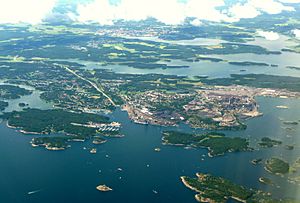Oxelösund facts for kids
Quick facts for kids
Oxelösund
|
|
|---|---|

2012 aerial view of Oxelösund with Nyköping in the background
|
|
| Country | Sweden |
| Province | Södermanland |
| County | Södermanland County |
| Municipality | Oxelösund Municipality |
| Area | |
| • Total | 11.57 km2 (4.47 sq mi) |
| Population
(31 December 2020)
|
|
| • Total | 11,420 |
| • Density | 987.0/km2 (2,556.4/sq mi) |
| Time zone | UTC+1 (CET) |
| • Summer (DST) | UTC+2 (CEST) |
Oxelösund is a town in Sweden. It is the main town of the Oxelösund Municipality. In 2018, about 11,488 people lived there.
Oxelösund is located less than 15 kilometers (9 miles) south of a bigger city called Nyköping. These two towns together form a larger area where almost 50,000 people live.
Contents
History of Oxelösund
People have used the harbor in Oxelösund for at least 500 years! It has always been an important place for ships.
Early Development of the Port
In the 1800s, more and more minerals were dug up from mines in central Sweden. This area was known as Bergslagen. Oxelösund became a very important port for shipping these minerals.
A train company started in 1873. This company bought almost the whole peninsula where Oxelösund is located. Before that, the land belonged to the large Stjärnholm Castle estates.
Growth with the Iron Works
An iron works (a factory that makes iron) was built in 1913. This made the community of Oxelösund grow a lot. The harbor, the railway, and the iron works were the main reasons for the town's growth.
Becoming a City
By 1950, Oxelösund had grown enough to be called a city. It was one of the last places in Sweden to get this special "city status." Since 1971, the idea of "city status" is not used anymore in Sweden. However, Oxelösund is still the main town of a municipality. This municipality is one of the smallest in the whole country.
Recent Events
In November 2011, Oxelösund hosted a big sports event. It was the Nordic Under-21 Championships for underwater rugby.
A place called Femöre battery is also located near Oxelösund. It's a historical coastal defense area.
Companies in Oxelösund
Oxelösund is home to some important businesses.
- SSAB: This is a big Swedish company that makes steel.
Climate in Oxelösund
Oxelösund has a climate that is a mix of two types: a maritime climate and a humid continental climate. This means its weather is usually not too extreme. The town is located at the end of a peninsula, and its weather station faces the open sea. This helps to keep the temperatures more steady.
In other parts of the town and further up the peninsula, the weather can change a bit more. This is especially true as you go further north, like in the nearby city of Nyköping.
See also
 In Spanish: Oxelösund para niños
In Spanish: Oxelösund para niños




